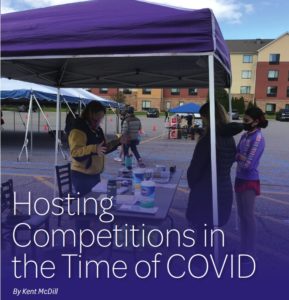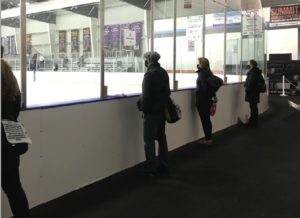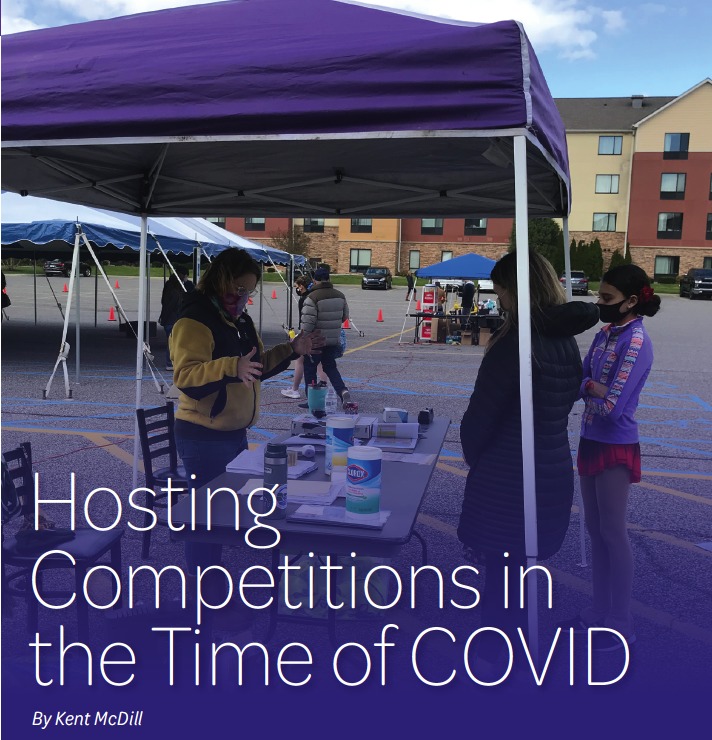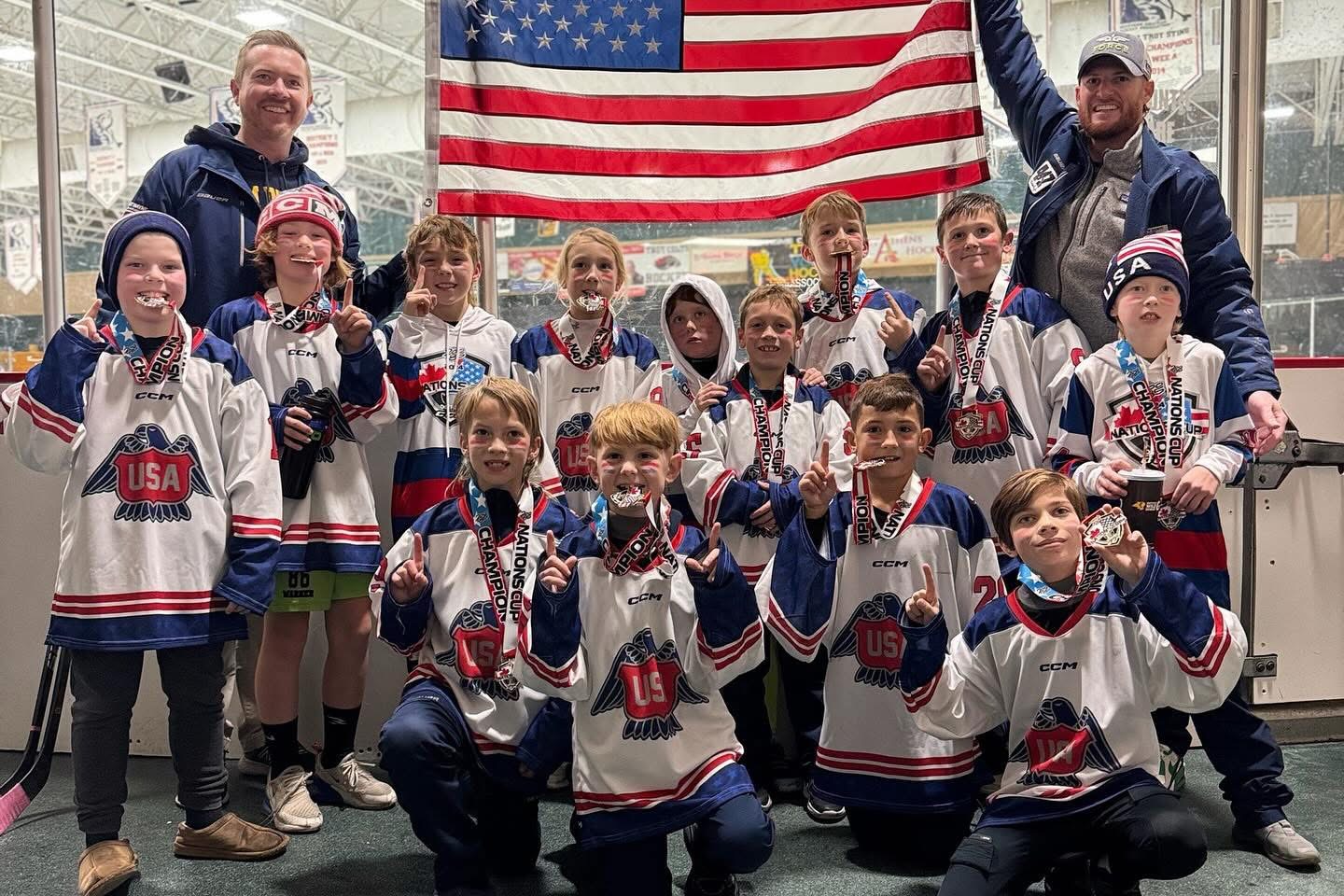Hosting Competitions in the Time of COVID
By Kent McDill – Professional Skater Magazine

In Alena Lunin’s mind, it was time.
After cancelling competitions in March and August due to concerns over the spread of COVID- 19, Lunin decided it was time to give it a shot. Skaters needed to skate, competitors needed to compete, and the skating world in the United States needed to come together again.
So Lunin, the skating director for the Fort Wayne (Ind.) Skating Club, put all of her efforts into creating the Battle of the Blades, which was held Oct. 2-4 at the SportONE Parkview IceHouse. Despite only having two weeks for registration, 243 skaters participated in the event, making it the
largest skating competition in the country since March 1, 2020.
Lunin has conducted competitions in Fort Wayne in the past, but this one was different because she had to consider an entirely new set of needs and requirements in order to make the event safe from the threat of the coronavirus.
“I felt I know what needs to be done to have a safe environment,” Lunin said. “But I also know how important it was for all level skaters to have an opportunity to be able to skate and show their programs and to give them all something to look forward to.”
Lunin has worked as a member of U.S. Figure Skating committees to determine how to proceed with competitions amid continuing co
ronavirus flares. She also found herself cancelling events in March and in August in Fort Wayne because the threat of spreading the virus was too great.
But her work on those two earlier events allowed her to come up with a plan for the October event.
The details
 There is one element all skating competitions include: a sea of humanity. There are skaters and coaches and judges and parents and grandparents and chaperones and skating fans, and they are all indoors. Lunin’s task was to limit the number of people who came within six feet of each other, and to limit the time any participant, coach or attendee spent inside the facility.
There is one element all skating competitions include: a sea of humanity. There are skaters and coaches and judges and parents and grandparents and chaperones and skating fans, and they are all indoors. Lunin’s task was to limit the number of people who came within six feet of each other, and to limit the time any participant, coach or attendee spent inside the facility.
So she started with the most difficult chore: limiting spectators. Unlike other competitions, where a skater
performs in front of everyone who has ever been invited to Thanksgiving dinner, the Battle of the Blades limited attendance to one chaperone and three spectators per skater. And that limitation prompted one of the more difficult phone calls Lunin experienced in hosting the event.
“I got a call from a grandmother,” Lunin said. “She said ‘I am dying, and if you do not allow me in, I won’t be able to see my granddaughter skate one last time’. That, of course, was not my decision. I had to put a limit on spectators for everybody.”
In order to limit the exposure of people inside the facility, Lunin set up tents outside as staging areas, where skaters and coaches could wait for their turn to enter the building under very tight time frames.
The facility has three rinks, and Lunin used all available entryways, including emergency exits, to separate spectators based on which rink their skater was competing in. Spectators were required to use outside stairs to get to their seats rather than battle their way through crowds ind
oors, and were required to leave once their skater had competed. Coaches and skaters had their own entrance to the facility, and judges were required to enter through a different door.
Everyone who entered the building had their temperature taken, and they were told that if they registered a temperature of 100.4 or above, they would not be allowed to enter.
Skaters were put onto a very tight time schedule. Their check-in was 25 minutes before their competition, and they had only 10 minutes in the “ready room” to make sure their costume and makeup were properly prepared. Competitors were encouraged to do as much as they could in terms of preparation in their hotel rooms prior to going to the facility.
Everyone was required to wear a mask at all times, with the exception of skaters when they were on the ice.
A special physical arrangement was created in order to allow for interaction between skaters and coaches during warmups and just before the competition began. Every other plexiglass shield that surrounded the rink was raised approximately eight inches so skaters could hear their coaching instructions.
“One of the coaches asked if we could raise the plexiglass a little bit higher so he did not have to bend down to speak to his skaters,” Lunin said. “But raising the glass would allow coaches to put their faces into the skater’s face, and we were not going to allow that. So it stayed at eight inches.”
A coach’s view
PSA Executive Director Jimmie Santee was coaching at the event. He was impressed by virtually every change that was made in order to keep participants and spectators in proper social distance. “There was no loitering inside the building at all, and no contact with anyone other than the people you were traveling with,’’ Santee said. “There was no coach’s room. There was a little more flexibility for the coaches, but they took our temperature every day when you showed up, and you got a wristband that indicated you had been tested.
“In the rinks, where they had lifted the plexiglass, they had signs for every skater: Skater No. 1, Skater No. 2, Skater No. 3, so we each had our own specific spot to talk to the skaters,” he said. “We were never on top of anybody else.”
Santee noted that there was an employee at each rink with a towel and disinfectant and “he just circled the rink, wiping the boards down continually. He never stopped going in circles.”
And then, it rained
The phrase is Yiddish in origin: “Man plans, and God laughs”.
Everything was going swimmingly until, ironically, it rained on Sunday. The tents, which were so hospitable on Friday and Saturday, became a bit more hectic, and spectators who were gathered outside in anticipation of entering were required to spend more time in their cars. But, the athletes were not as willing to wait endlessly out in inclement weather before competing.
“The athletes could not be out in the rain,” Santee said. “The parents wanted to be underneath the tent. That is a factor for competi
tions moving forward. I don’t know how they can overcome that without having 20 tents. It is going to be dependent on good weather, and if it is somewhere like Minnesota, we already have snow, we are already into winter. That is something they are going to have to overcome and I’m not sure how they are going to do that.”
Was the competition affected by COVID?
There were fewer spectators in the stands, and there was a lot less confusion in the facility hallways. Skaters who were accustomed to certain pre-skate rituals had their schedules impacted. Everything prior to actually competing was a little bit different.
But the competition went off without a hitch.
“The stuff that went down on the ice, it was like there was nothing different,” Santee said. “Skaters are resilient. When they came into the b
uilding, they put their skates on, they had an opportunity to warm up. It was well scheduled that way. It really did not affect the competitors.”
“There was more structure,” Lunin said. “Everybody knew where to go and what to do. It was better that way.”
And there was an unexpected (and possibly humorous) virtue to competing at the time of COVID. “I think it was less stressful for the skaters because the parents weren’t there,” Lunin said. “Coaches weren’t by them every minute.”
“In some ways, it probably had less pressure,” Santee said. “They were just thankful to be there and to be able to skate and compete. Yes, everybody was concerned about passing COVID around, but within my group, everybody was doing what they were supposed to do, staying masked, keeping social distance. I think that was very successful.”
Lessons learned
Santee said the precautions necessary to have a successful competition in the time of COVID reminded him of the precautions made when the federal Safe Sport program was instituted to protect athletes from bullying, harassment, hazing, or abuse of any kind.
“When Safe Sport came about, that set up a whole new set of issues, and you had to have all these protections limiting people into certain areas,” Santee said. “COVID is like that. I don’t think it is as big of a leap to make some of the other additional changes. Most clubs that do competitions are pretty adept at adapting.”
Santee noted that Skate America was about to be conducted in Las Vegas using the “bubble” system the NBA, WNBA, and NHL used to conduct their truncated seasons, keeping all athletes, coaches and judges in one area with no permitted access outside of that area.
While Lunin noted the extra time required to prepare a facility to host a major competition, Santee said he was not as concerned about cost for events going forward as he is about revenues.
“The issue is more the number of skaters the event can draw or accommodate, which might lower the revenue,” he said. “That is more of the trick. It is probably going to be reflected more on the revenue side than the expense side.”
That was, in fact, a concern for Lunin and the Fort Wayne Skating Club because there was only a two-week window for registration. Future events will be able to plan for more time to attract competitors.
Lunin said skating needed to move forward in order to survive.
“You want to prove it is possible, but we have to be smart, make sure we take the correct steps and precautions,” Lunin said. “Our work will die if we are not allowed to have competitions.”




